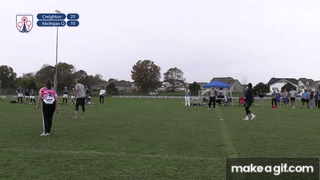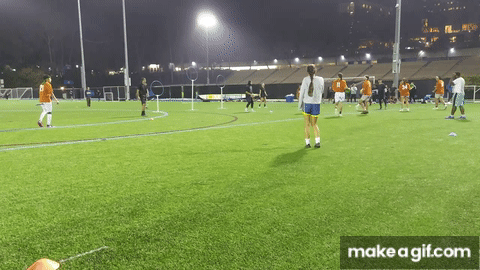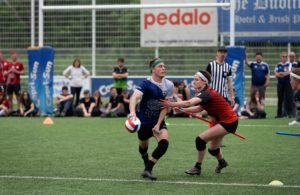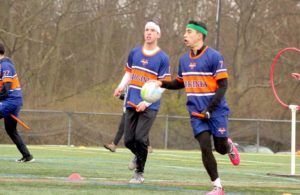- Rule, Britannia, no more?
- Unpopular Opinions: US Quadball Cup 2023
- Proven Contenders: University of Virginia
- Proven Contenders: Rutgers University
- Proven Contenders: University of Michigan
- Proven Contenders: Creighton University
- Different Perspectives: A Look Inside USA Ultimate
- Antwerp QC, Much of Belgian Core, Leaves Competitive Quidditch
Proven Contenders: Creighton University
- By Ethan Sturm
- Updated: April 10, 2023
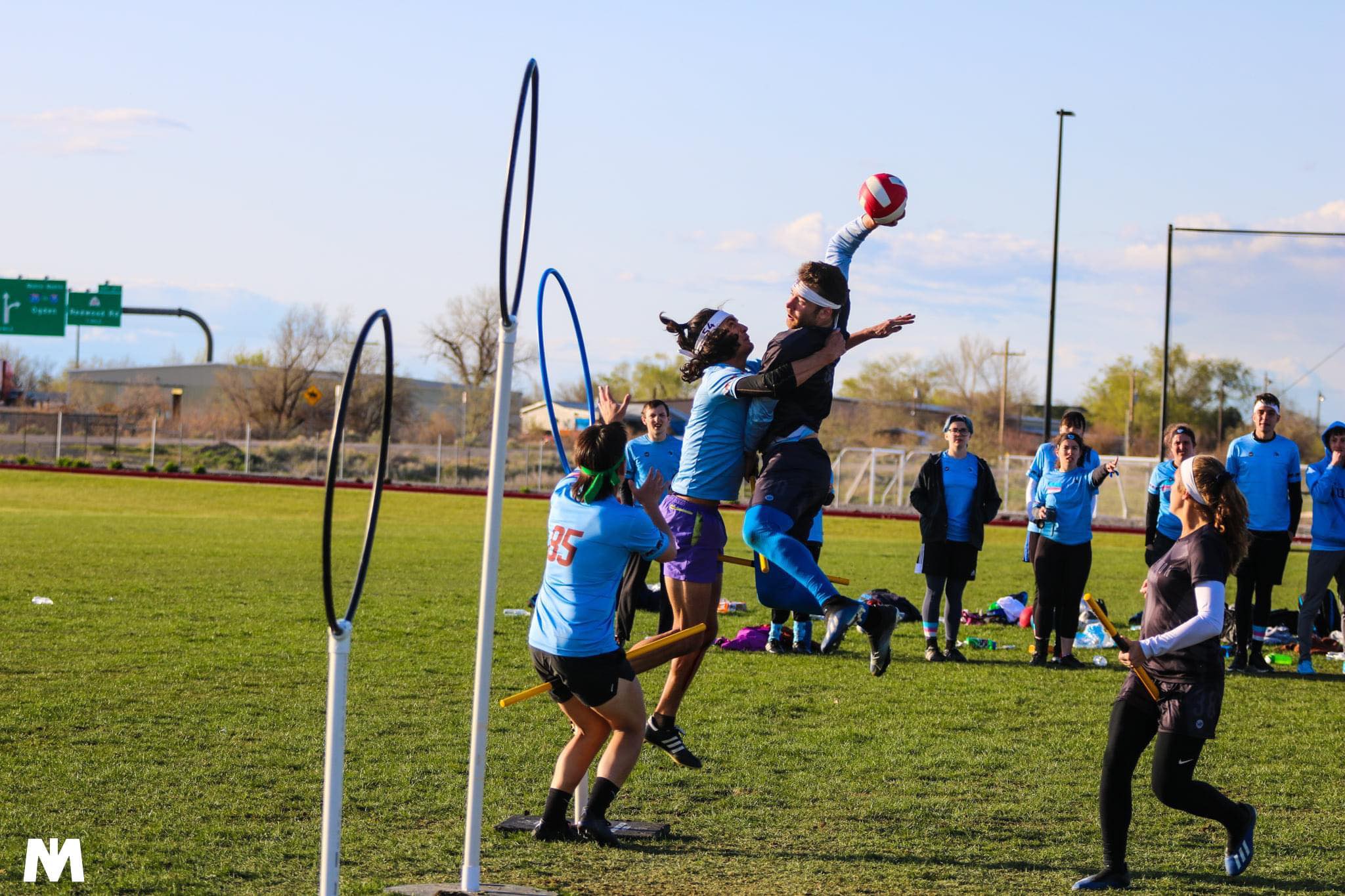
Photo: Mike Iadevaia
No. 1 Creighton University
Record: 22-3
Vs. Top 10: 7-3
Defensive Sets: 2-2 Zone, Half-Court Press
Strengths: High Pace of Play, Seeking
Weaknesses: Hoops Zone, Half-Court Defense
A year ago, Creighton University entered the USQ Cup as the second best team in the country, and looked every bit the part, coming up one game short against arguably the most-talented college team to ever take the pitch. While some doubted the team’s ability to be a 2023 contender after suffering some key losses to graduation, they proved those naysayers wrong. Creighton will enter nationals as the most well-tested team in the country, and the favorites to win the title.
The team entered the fall with the goal of repeating their feat last season of winning both the Great Lakes and Midwest Regional Championships. This mission fell flat, with the No. 4 University of Michigan beating them once on Saturday in pool play of Great Lakes, 165-120, and then a second time on Sunday in the finals match, 180-170. Creighton did rebound to claim the Midwest Regional Championship crown with minimal opposition, but made their real statement of the fall at Diamond Cup, blowing out both No. 5 UTSA and No. 9 Sam Houston by over 100 points.
They opened the spring semester at the Heroes vs. Villains Invitational, getting their revenge on Michigan and beating the No. 7 University of Texas twice to win the entire tournament. But in the finals of their home tournament, Blue Jay Classic, which the team has never won, No. 6 University of Missouri sent Creighton off to nationals on a sour note, with a 155-90 upset victory that sent shockwaves through the country.
On the surface it would be easy to assume this year’s Creighton team operates similarly to the 2021-22 rendition. Watching tape, you will see the high press that has served them so well and athletic quaffle players beating point defenders off the dribble, hitting the lane and sinking mid-range shots with ease.
But to assume this premise misses a key distinction between the two iterations of the team. Whereas last year, it was elite quadball play, led by superstar Darian Murcek-Ellis, that covered for shortcomings in the beater game, this season, it is often the beater game that covers for shortfallings amongst the chasers. Last year’s team could score on offense with even a second’s distraction from a beater, while this year’s team often needs a fast break or no-bludger situation created by the beaters. Last year’s team used the high press to minimize the traditional beater exchanges the team’s beaters had to take, while this year’s team can be successful in both standard and aggressive defensive sets because its beaters can win exchanges in either scenario.
With so much talk about the beaters, it seems only right that we focus on them first. Creighton runs out two beater pairs in big games: Max Chang and Lauren Curry start games, with TJ O’Connor and Madi Namanny subbing in behind them. Chang, who often relied on his athleticism and physicality to bail him out last season, has developed into a complete beater and is much more comfortable relying on the skills he has grown over the past year to enhance the damage his speed can do on the pitch. Curry, who serves as the free beater in the pair, plays effortlessly off Chang, and constantly makes the right split-second decision in pressing situations, one of the most complex scenarios for a beater to juggle. Namanny continues to be the solid, consistent presence in the defense that caught eyes last season when she was still playing for Blue Jay Quadball. But it’s O’Connor who is the star of the group, bursting onto the college scene this season with plus skills, plus decision making and plus athleticism, a complete skill set rarely seen in the college game recently. O’Connor’s ceiling is sky high, and how close he can get to it by nationals may make all of the difference for Creighton’s title ambitions.
The quaffle game is anchored by the ball-handling of Joe Goulet and Riley Usami, both of whom are most comfortable using their athleticism to get in the lane and causing havoc from there. Watch either of the team’s games against Michigan at the Great Lakes Regional Championship, and you will see Usami making plays like this one over and over again.
But it’s this one-dimensional nature in the half-court that has also caused problems for Creighton in the half-court, especially against teams willing to play a Hoops Zone against them. The team’s recent loss to Mizzou, as well as its slow starts in games at HVI against Michigan and Texas, were full of offensive possessions that died on mid-range shots that were swallowed up by the defense. True, threatening incisive passes also remain rare, in part due to the team’s chasers’ affinity for one-handed catching. And while Ryan Mehio is happy to drive a ball all the way to the hoop, many of the other top scorers on the team remain hesitant.
Defensively, Creighton offers two main looks. The first, and most well-known, is their high press. Chang or O’Connor takes an engage right at half court, with Namanny or Curry following up the play to force the turnover. With the amount of speed in the quaffle game, any turnovers forced are often immediately points going the other way. Especially when Creighton’s beaters are favored, this press allows them to put opposing teams away faster than anyone in the country.
This semester, especially in big games, Creighton has also been working on a 2-2 zone look that has more in common with the University of Maryland’s hybrid zone, with the top two players pushing high up in defense, than it does with more traditional, conservative 2-2 zones run across the country. But in the few tournaments since the team has broken out the zone, it has often looked sloppy, either due to a lack of physicality from the top chasers or from questionable rotations down behind the hoops. This has allowed for plentiful opportunities for points, even when the opposition has not taken advantage.
While they got away with these mistakes against less-dynamic offenses like that of Texas, they have not actually faced off with many of the more pass-heavy offenses of the Northeast. And if Mizzou showed us anything at Blue Jay Classic, it’s that two or three strategically-placed passes can open this defense up.
Of course, to upset Creighton, a team wouldn’t likely just need to hang around in the quadball game, they would also probably need to catch a flag runner. And, on the back of Goulet’s seeking, that is where Creighton has been all but automatic. The team has played 18 official games with Goulet on roster, and in those games they have caught 12 times while only allowing two catches. Goulet uses his size and speed to come up with grabs quickly and consistently, and has clearly benefited from the tutelage of US National Team seeker Ryan Davis. Their only loss with him on roster came when Mizzou’s beaters did not let Goulet within 20 yards of the flag runner.
While there may be a game script to beat Creighton, at this point the team has seen it. If they can adjust and patch over their weaknesses, it is difficult to imagine teams hanging with them for an entire game, especially as Sunday goes longer and the depth of the program shines through. No team from the Midwest has ever won a national title, but this year, Creighton looks poised to change that.
Related Posts
About Ethan Sturm
Ethan is the co-founder and former managerial editor and chief correspondent of The Eighth Man. When not talking quidditch, which is rare, he can be found drilling people's teeth and spending time with his elusive wife. He's also the worst.

